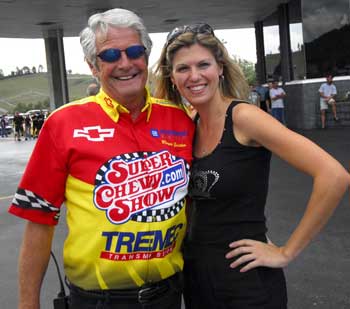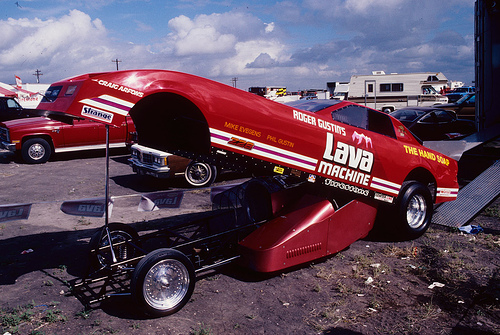Roger Gustin, 2012 East Coast Drag Times Hall of Fame Member, Jet Dragster Pioneer and Super Chevy Shows Passes Away at 76

Roger Gustin began his driving career in nitro Funny Cars, then in 1971 he moved to jet dragsters. Daily-C, a vitamin C supplement was among several mainstream consumer companies he signed.

Roger Gustin (left), Cleveland, Ohio racer and chassis builder Joe Schubeck (Lakewood Industries) and “Papa Kook” George Kryssing (Kook’s Headers) share memories during Roger’s 2012 Hall of Fame induction. Roger Gustin gained early fame as a Funny Car and jet car driver and promoter of the Super Chevy events.

Roger Gustin bought AutoStar Productions, producers of the Super Chevy Shows events, and grew them into a nationwide series. Roger was always on hand at his events, making sure everything moved smoothly.

Lava hand cleaners was another Gustin consumer products sponsor. Roger’s professional, easy-going manner opened doors for his many lucrative deals with companies thought to be outside the possibility of drag racing sponsorships.
Hall of Fame Story by Jim Hill
East Coast Drag Times Hall of Fame 2012 inductee and one of drag racing’s pioneer jet dragster and Funny Car drivers, Roger Gustin, passed away December 14, at the age of 76. Roger had recently undergone treatment for cancer. Just as he always did, Roger fought hard all the way to the finish line.
Roger, his brothers Bill and Phil grew up on a southern Ohio farm. The Gustin Brothers worked hard and learned all the basic skills needed for everyday farm life and racing. These included fabricating, welding, engine building and tuning.
Roger’s driving career began in 1957, with a ’49 Chevy. Within a couple years the Gustin Brothers were running a ’55 Chevy at tracks in southern Ohio and across the Ohio River, in Kentucky. A local Lincoln-Mercury dealer, recognized their untapped talents and offered sponsorship help. In spite of moving from a small-block Chevy to a big-block FE Ford, their efforts proved successful. Soon the Gustin Brothers were running an unblown ’66 Mercury Cyclone Funny Car with 427 FE power, Hilborn injection and a healthy dose of nitromethane fuel.
The car was initially competitive, but that ended when the lightweight, Logghe chassied, flip-top, fiberglass bodied Mercury Cyclones of “Dyno Don” Nicholson, “Fast Eddie” Schartman and “Jack The Bear” Chrisman hit the strips. Nothing less would do, so the Gustin Brothers bought a Logghe chassis and built their own ’66 Comet, with a 427 SOHC Ford. Eight second, 180+ mph times followed along with attention Ford’s Lincoln-Mercury division and a sponsorship.
In 1971 the factory sponsorship ended and racing costs were soaring. Roger did not want to quit racing, so he surprisingly moved into the equally exotic world of exhibition jet powered dragsters. These cars were still somewhat primitive, dangerous and crash-prone. Although they could easily exceed 230 mph, stopping the heavy jets was dicey and disastrous should a parachute failure occur. They were also officially outlawed by NHRA and AHRA.
Tracks and spectators loved the “weenie roasters” however. Roger’s first jet dragster proved to be both popular, profitable and easily booked with track owners eager to pack their stands with the loud, noisy, smoky jets. Fuel costs were minimal, and jet fuel was easily obtained at any airport. The engines were military surplus items, usually from a jet fighter, and needed maintenance only occasionally. After all, these engines were engineered and built to deliver thousands of hours of flight time with unquestioned reliability.
The main expenses in racing a jet car were fuel costs for the tow truck, driver fees and a crewman capable of starting and retrieving the car after a run. At season’s end the engine, brakes and parachutes were serviced or replaced, readying the car for another profitable racing season.
It wasn’t until 1977 that NHRA finally decided that jet dragsters and Funny Cars were safe and they instituted a license program for the jet cars and their drivers. Suddenly jets were a part of “big show” races, and still a major attraction as feature vehicles at small tracks across the nation. Roger Gustin’s reputation soared as one of the premier jet performers, as did his “bookability” with track promoters.
Roger moved from jet dragsters to Funny Cars, providing crowds with a more recognizable vehicle, and larger billboard space for sponsor products. He also had a talent for convincing sponsors that his flame spewing, thunderclap advertising media was safe and above all, highly noticeable. Roger was especially successful in wooing consumer products companies. Over the years these included: Sherbits candies; Vita-C Vitamin-C tablets; Smith Brothers Cough Drops; Black & Decker Tools and Lava Hand Soap. Roger knew what sponsors wanted, and made sure to over-deliver on all the things he promised as part of the deal.
Roger’s driving days came to an end in 1992 after he survived a major crash at Atco Dragway, in New Jersey. His injuries were enough to convince him to focus on promoting his jet cars. He was also now the owner of AutoStar Productions. AutoStar produced a nationwide series of car enthusiast events, car shows and drag races under the name Super Chevy Shows. The events were affiliated with Super Chevy Magazine, and covered with multi-page spreads in all their issues.
The concept was so successful it spawned other “car make-specific” events such as Fun Ford Weekend and the Mopar Nationals, all geared to gearheads and their favorite car make.
Roger ran the Super Chevy Shows events until he sold his AutoStar Production interests and slowed down, but only slightly.
During his lengthy and star-studded career Roger Gustin was inducted into the NHRA Drag Racing Hall of Fame in 1980, the Pro-Jet Association Hall of Fame in 1993, Don Garlits’ International Drag Racing Hall of Fame, in 2002, and the East Coast Drag Times Hall of Fame, in 2012.
Roger Gustin was a dedicated racer, an innovative and resourceful car builder, a gifted event promoter, and a visionary in the sport of drag racing. He was also friendly, approachable and straight-shooting, well liked and highly respected by everyone he came in contact with.

